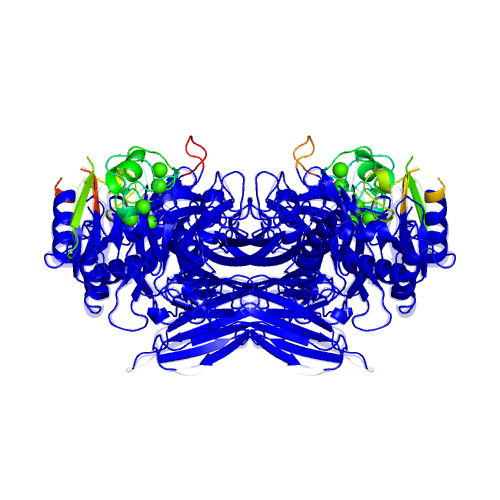CL.3 |
PROTEIN-ARGININE DEIMINASE TYPE IV |
|
|
|
Function |
EC*1 |
CSA distance*2 |
3.5.3.15 |
7.5 |
|
*1 Enzyme commission number. |
Ligand |
PDB*1 |
Full name |
8xCA |
8x(CALCIUM ION) |
|
*1 Ligand name designated by the PDB identifiers. |
Segments |
Component No. |
Fixed*1 |
Moving*1 |
Motion type |
Ligand binding |
Coupled motion type |
1 |
D1(4A-33A,39A-53A,68A-97A,100A-124A,136A-154A,177A-217A,225A-312A,317A-322A,320A-330A,351A-369A,389A-395A,403A-515A,523A-632A,645A-663A,4A-33A,39A-53A,68A-97A,100A-124A,136A-154A,177A-217A,225A-308A,320A-330A,351A-369A,389A-395A,403A-515A,523A-632A,645A-663A) |
L2(155A-176A) |
Local |
Coupled |
Closure |
2 |
D1 |
L3(370A-388A) |
Local |
Coupled |
Closure |
3 |
D1 |
L4(633A-644A) |
Local |
Independent |
|
4 |
D1 |
L5(309A-312A,317A-319A) |
Local |
Independent |
|
5 |
D1 |
L6(396A-402A) |
Local |
Independent |
|
*1 The location of the fixed and moving segments indicated by the residue number assigned in the ligand-bound form. The background color of characters indicates the corresponding segment in the structure. The colored segments not described in the Table are: 1) a part of component in which the motion is small (< 1.0 A), or, 2) a part of a protomer of homodimers, for which a corresponding part of the other protomer is shown in the Table. |
Displacement and disorder |
Component No. |
RMSD*1 |
Displacement*2 |
Disorder-order transition*3 |
Disorder residue*4 |
Helix-Coil*5 |
1 |
Yes |
+14 |
|||
2 |
Yes |
+17 |
|||
3 |
Yes |
+12 |
|||
4 |
Yes |
+3 |
|||
5 |
Yes |
+7 |
|
*1 The root-mean-square displacement of a component of motion calculated for the domain motions. |
Linear response |
Component No. |
Correlation coefficient*1 |
1 |
0.83 |
2 |
|
3 |
|
4 |
|
5 |
|
*1 The correlation coefficient between the displacement vector predicted by the linear response theory and the one observed in the crystal structures. |

